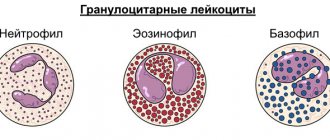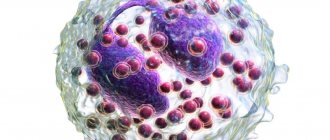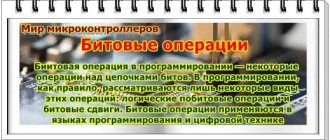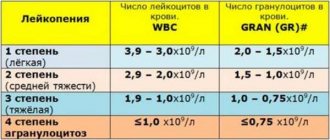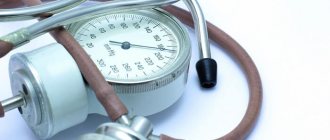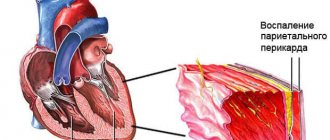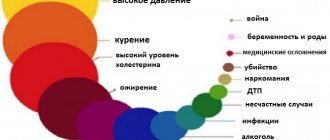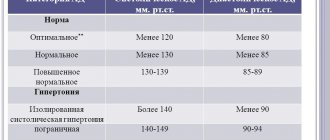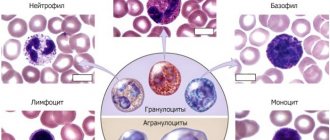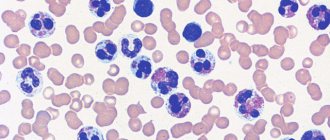Functions in the body
Eosinophils are a type of white blood cell. They help control the process of binding foreign proteins in the circulatory system. The cells are completely transparent and contain enzymes that have the ability to dissolve the absorbed protein. The main site of eosinophil formation is the bone marrow.
They stay there for a week, during which time they mature. And then they move into the circulatory system and it takes only a few hours. Once they reach certain tissues, they remain there for several weeks.
They perform several functions in the body:
- actively participate in inflammatory processes, especially those that are closely intertwined with an allergic reaction;
- take part in the formation of certain organs;
- destroy hazardous substances that enter the body;
- have bactericidal and parasitic activity.
Eosinophils can bring not only benefits, but also harm to the body. More often, they are entrusted with the function of protecting the body from pathogenic microorganisms entering it. But with some ailments they can provoke various pathological changes.
How and under what conditions is it produced?
Eosinophils are a type of white blood cell produced by bone marrow tissue. The number of these cells increases if the body develops an allergic reaction, it is infected with a fungus, virus or parasites.
If there is no negative impact on the body, then the number of eosinophils is always normal without any sharp fluctuations. After entering the blood, the cells remain in it for no more than 12 hours, and then penetrate into the organs of the digestive system, where they accumulate. The cells remain in the tissues for 12 days, providing an antibacterial and anti-inflammatory effect on the body.
Eosinopenia in adults
Eosinophilic granulocytes are produced in the bone marrow and circulate in the bloodstream for a very short time. The entire residence time of the granulocyte in the general bloodstream is 8–12 hours, after which it passes into the tissue.
This means that when there is a high need for eosinophils, for example, during myocardial infarction, acute allergies, the amount of EO quickly falls below normal and does not have time to be replenished. It takes some time for the bone marrow to restore the normal level of white blood cells in a given population.
Thus, after eosinophils dropped to 0% on the first day of acute myocardial infarction, already on the second day the number of these cells in the general bloodstream is restored.
Reduced EO during treatment with antitumor drugs, cytostatics. Drugs in this group not only affect cancer cells, but also block all 3 lines of hematopoiesis in the bone marrow, which reduces the number of all types of blood cells.
The cessation of maturation of eosinophilic leukocytes in the bone marrow may be caused by dysregulation of EO production with decreased synthesis of interleukin IL-5.
The IL-5 protein is produced by T lymphocytes and stimulates the formation of eosinophils and B lymphocytes. If T-lymphocytes are reduced, then the concentration of IL-5 decreases, which means that the production of eosinophils is also reduced.
A decrease in EO is observed in adults in the case of:
- acute conditions - with acute respiratory infections, appendicitis, dysentery, typhoid, myocardial infarction;
- inflammation of the bile ducts, pancreas;
- purulent infections - tuberculosis, streptococcal, staphylococcal infections, pseudomonas, Escherichia coli, sepsis;
- B12-deficiency anemia;
- painful, toxic shock;
- diabetic, uremic coma;
- autoimmune processes;
- treatment with adrenocorticotropic hormone, nicotinic acid, nicotinamide, antidepressants;
- Cushing's syndrome;
- emotional or physical stress;
- surgery, severe injuries, extensive burns;
- pregnancy, childbirth;
- malignant diseases.
If a decrease in eosinophils in the blood to 0% is accompanied by decreased levels of neutrophils and basophils, then this condition in adults serves as the basis for a worsening prognosis of the disease.
Indicator table is normal
Whether eosinophils in women, men are low or high - this can only be determined by knowing what their norm is in the body. The table below shows eosinophil levels depending on the gender and age of the person.
| Age | Norm for women (units per 1 microliter of blood) | Norm for men (units per 1 microliter of blood) |
| 18-29 years old | 120-165 | 120-160 |
| 30-39 years old | 165-260 | 160-250 |
| 40-59 years old | 260-320 | 250-310 |
| People over 60 | No more than 350 | No more than 350 |
Normal values for men and women are considered eosinophils in the range of 120-350 units. With age, chronic illnesses develop, a tendency to allergies appears, and the immune system weakens significantly due to exposure to external factors.
The norm of eosinophils in the blood
The number of eosinophils is determined during a detailed general blood test with leukocyte count and ESR.
Normal eosinophil count for adult men and women
The calculation can be carried out in absolute (EO#) and relative (EO%) values. The absolute content is determined if the relative number of leukocytes as a whole deviates from normal.
However, if in healthy men the level of eosinophils is stable in the specified reference range, then in women of reproductive age characteristic “waves” are observed. This fluctuation occurs due to menstrual cycles, and it is its indicators that are used in the test to assess the functioning of the ovaries and determine the onset of ovulation.
The norm of eosinophils (EO%) in the blood of pregnant women is about 1.5%.
The norm of eosinophils for a child of different ages
What is characteristic is that the number of eosinophils changes throughout the day, and directly depends on the cyclic fluctuations in the functioning of the adrenal glands: in the morning the values are below the daily average, and at night they are increased, but are within the reference limits.
Symptoms of decline
There is no clinical picture with low eosinophil levels. Symptoms depend on what exactly led to their decrease. In some cases, symptoms may not appear for a long time.
In general, symptoms can manifest themselves in the form of the following signs:
- general malaise;
- high body temperature or low-grade fever;
- dysfunction of the digestive system;
- blood pressure surges;
- decreased appetite;
- sudden weight loss for no apparent reason;
- skin rash;
- swollen lymph nodes;
- cold symptoms: cough, runny nose, sore throat;
- apathy, irritability;
- pain in the chest area, radiating to the back and arm.
If at least some of the above symptoms appear, then you need to seek advice from a specialist.
Symptoms and signs
There are no signs that characterize eosinophilia as such, since it is not an independent disease. Although, under the influence of certain factors, when eosinophils in the blood are reduced, patients complain of similar symptoms.
For pathologies of a parasitic nature:
- lymph nodes, liver and spleen enlarge;
- the development of anemia is noted - especially against the background of damage to the intestinal system, malaria;
- weight loss;
- the temperature always remains within the subfebrile range;
- joint and muscle pain, lethargy, and lack of appetite appear;
- dry paroxysmal cough and skin rashes occur.
Important information: What is WBC in a child’s blood test (table of interpretation and norms)
The person complains of constant fatigue, loss of body weight and a feeling of hunger even with increased food consumption, dizziness due to anemia, prolonged causeless hyperthermia. Such signs indicate poisoning of the body with waste products of helminths and other harmful microorganisms, an increase in an allergic reaction to them, and disruption of digestive function and metabolism.
If low eosinophils in an adult are accompanied by allergies, the development of skin itching (nettle fever), blisters, swelling in the neck (Quincke's edema), and a characteristic urticarial rash is noted.
Collapse, a sharp decrease in blood pressure, skin peeling and shock are possible.
If low eosinophilic cells have led to damage to the gastrointestinal tract, the patient complains of vomiting, diarrhea, pain and discomfort in the abdomen, blood or pus in the stool due to colitis. In this case, the symptoms are due to the development of the disease in the gastrointestinal tract.
When eosinophils below normal are accompanied by oncology, the occurrence of fever, lethargy, weight loss, joint and muscle pain and aches, an increase in the size of the liver, spleen and lymph nodes, and diseases of an infectious-inflammatory nature are observed.
Reasons for the downgrade
Reduced eosinophils in women are the first sign of exhaustion of the body. Eosinopenia (as doctors call low levels of eosinophils) is observed under conditions of constant stress:
- initial stage of infection;
- the patient's condition after surgery;
- burns;
- extensive chest grass;
- myocardial infarction;
- malignant formations;
- various injuries;
- blood poisoning.
Too low a cell level may indicate the development of such diseases:
- dysentery;
- acute appendicitis;
- typhoid fever;
- pneumonia;
- peritonitis;
- sepsis;
- toxic shock;
- severe fatigue and physical stress;
- stress;
- systematic lack of sleep.
Eosinophils are reduced in women or men due to taking certain medications: antibiotics, analgesics, corticosteroids. Physiological reasons may be the period during gestation and after delivery.
Causes of pathology
If eosinophils are elevated, it is necessary to identify the cause, since the pathology is a symptom of a disease, and not a separate disease. An increase in the number of these blood cells indicates intensive work of the immune system, and does not always require treatment.
There are several prerequisites for the development of eosinophilia:
- Parasitic infections;
- Allergic reactions;
- Diseases of internal organs;
- Blood diseases;
- Dermatological pathologies;
- Autoimmune diseases;
- Infections;
- Formations of a malignant nature.
Parasites
A blood test reveals eosinophilia when a person is infected with helminth infections. The following diseases may be the cause:
- Toxocariasis;
- Opisthorchiasis;
- Giardiasis;
- Ascariasis;
- Filariasis;
- Strongyloidiasis;
- Malaria;
- Paragonimiasis;
- Echinococcosis;
- Trichinosis;
- Amoebiasis.
Allergy
An allergic reaction occupies a leading place among the causes of increased eosinophils. The condition develops when:
- Hay fever;
- Quincke's edema;
- Bronchial asthma;
- Allergic reaction to medications;
- Hay fever;
- Serum sickness;
- Rhinitis of an allergic nature;
- Hives;
- Fasciitis;
- Myositis, etc.
Diseases of internal organs
Eosinophilia manifests itself in diseases of the following organs:
| Lungs | Gastrointestinal tract | Heart | Liver |
| alveolitis | gastritis | myocardial infarction | cirrhosis |
| pleurisy | colitis | birth defects | |
| Loeffler's disease | ulcer | ||
| sarcoidosis | gastroenteritis | ||
| histiocytosis | |||
| aspergillosis | |||
| pneumonia | |||
| presence of infiltrates | |||
Blood diseases
An increase in eosinophils is observed in erythremia, myeloid leukemia, lymphogranulomatosis, polycythemia, pernicious anemia, Sezary syndrome.
Dermatological pathologies
Almost any skin disease leads to elevated eosinophils:
- Lichen;
- Pemphigus vulgaris;
- Contact or atopic dermatitis;
- Pemphigus;
- Eczema;
- Fungal disease.
Autoimmune conditions
Often, a blood test reveals an increase in eosinophils in scleroderma, SLE (systemic lupus erythematosus), and a large number of these cells are formed when the transplant is rejected.
Infections
Infection in the body always causes eosinophilia. The condition can be provoked by both the acute phase and exacerbation of chronic diseases:
- Scarlet fever;
- Tuberculosis;
- Gonorrhea;
- Mononucleosis;
- Syphilis, etc.
Malignant tumors
Various forms of malignancies, including lymphomas and lymphogranulomatosis, cause an increase in eosinophil cells in the blood. Tumors can be localized in various organs: genital or internal organs, thyroid gland, skin, stomach, etc., the condition worsens with the appearance of metastases.
Indications for the study
A general practitioner or family doctor can give a referral for testing to diagnose eosinopenia if there is a suspicion of:
- bronchial ac src=»https://healthperfect.ru/wp-content/uploads/2019/08/vinilin-balzam-shostakovskogo-3.jpg» class=»aligncenter» width=»600″ height=»321″[/ img]
- hay fever;
- allergic reaction;
- the presence of Giardia, worms and other parasites in the body;
- exacerbation of chronic infectious diseases;
- inflammatory process accompanied by purulent discharge;
- Quinte's edema;
- systemic ailments affecting the circulatory system;
- arthrosis, arthritis, periarthritis;
- disrupted blood formation process;
- pathologies of the skin.
How to determine
A low level of eosinophils in a person’s blood can be detected using a general blood test. The collection is carried out in the morning and only on an empty stomach.
To make a more accurate diagnosis, the specialist may additionally recommend other studies:
- blood chemistry;
- general urine analysis;
- ultrasound examination of internal organs;
- liver tests;
- tumor markers;
- genetic tests.
What values are considered reduced?
Normally, eosinophils in the bloodstream should not exceed 1-5% of the total volume of leukocytes. The level of these bodies can change throughout the day. For example, the eosinophilic index is reduced during the day, and during night rest it increases to its maximum.
According to standards, the number of eosinophils in the blood of an adult and a child over 13 years of age should be 0.5-5%, which in absolute numbers means 0.02-0.03*109/l. While in children this figure is slightly higher - 0.5-7%.
Eosinophils may be absent in adults if eosinopenia has begun to develop, a condition during which the number of cells in the bloodstream decreases.
In the case when the proportion of eosinophils in an adult is 0 in the leukocyte formula, but the level of blood cells themselves remains unchanged, this means that relative eosinopenia is developing.
Important information: What do elevated red blood cells in a child’s blood indicate?
A reduced level of eosinophilic cells in women after fertilization is the norm (sometimes they are completely absent), since leukocytes perceive such an egg as a foreign body and destroy it.
Preparing and conducting analysis
To get the most accurate result and find out the number of eosinophils in the blood, you need to properly prepare for the sampling, following these recommendations:
- 48 hours before blood sampling, remove alcoholic beverages, coffee and strong tea from the diet;
- the day before the analysis, remove fatty and fried foods;
- 3 days before collection, remove smoked meats and seasonings;
- if a person is taking medications, the doctor must be notified about this so that he takes this into account;
- Any physical activity is prohibited the day before visiting the laboratory;
- eliminate stressful situations, emotional stress;
- Avoid smoking half an hour before the test.
Doctors must take into account the decrease in eosinophils in the blood during ovulation. During this period, the level of progesterone in the body increases, which naturally reduces the number of eosinophils. At this point, the analysis will definitely show eosinopenia. This effect is also observed during stress and overwork. In this case, it is necessary to repeat the analysis after 5-7 days.
Blood is drawn from a finger.
What to do
Sometimes it is not possible to find out why there is a decrease in eosinophils in the blood. In addition, with a short-term decrease in the level of these bodies, separate therapy is not required.
The goal of treatment is to combat the factor of change in test results:
- When the cause is bacterial infection, the basis of therapy is most often antibacterial drugs. As a supplement, you may be prescribed medications that support the intestinal microflora - probiotics and restrictions on the consumption of fried, fatty, canned and smoked products.
- If a low level of eosinophils is caused by toxic substances, detoxification treatment and symptomatic therapy are prescribed. In case of disruption of the heart and blood vessels, arrhythmia and shock are treated, and tracheal intubation is performed against the background of acute respiratory failure. In case of a critical disorder in the functioning of vital systems, artificial blood circulation or ventilation, hemodialysis can be used.
Important information: What is MCV or mean erythrocyte volume in a blood test (deciphering the norm in the results)
With sustained relief of painful sensations through local action, antispasmodic and analgesic drugs, the level of eosinophilic cells in the blood is normalized.
When the condition stabilizes, remission occurs or the underlying pathology is cured, the indicators in laboratory blood flow tests stabilize. Do not forget that it is strictly forbidden to use medications when there are few eosinophils in the bloodstream, without medical advice.
To prevent the occurrence of conditions that can lead to the eosinophil count being lower than normal, and to strengthen the immunity of the entire body, you need to follow some rules. A person should adhere to a balanced diet, drinking regime, exercise the body moderately, walk outside more often, not get too cold, and be sure to follow a work and rest schedule.
Decoding the results
It is not difficult to independently decipher the level of eosinophils in a blood test. The study itself is carried out on the basis of the leukocyte formula. This technique helps calculate the percentage of white blood cells to the total blood count. Eosinophils should be within 1-5%.
It is thanks to the leukocyte formula that it is possible to analyze the immunological reaction of the body. It is important not to pay attention to the total number of leukocytes, but to their components.
You need to pay attention to the level of eosinophils, monocytes and basophils, and not the volume of leukocytes (it may be normal); if the number of leukocyte components is increased or decreased, this may indicate the development of a serious illness.
Normal concentration of eosinophils in the blood
In medical practice, two values of the total number are distinguished. The total volume characterizes the total number of eosinophilic cells. Relative level coefficients express the quantitative composition of eosinophils in relation to leukocytes.
Normal indicators in the female and male body are almost the same, but often fluctuate with age categories. Absolute indicators are not as important for diagnosis as the leukocyte formula.
In an adult, eosinophils are normal if their number does not exceed 5% of the total number of leukocytes. In a small child under 13 years of age, the norm of eosinophils is from 0.5% to 7%, in adults from 0.5 to 5%.
When to see a doctor
Eosinophils in women are reduced, and monocytes, on the contrary, are higher than normal - this indicates that the patient is recovering from an infection. And when there are 0 eosinophils, this indicates the development of a bacterial infection.
In women, an indicator close to 0 indicates the following ailments:
- ovarian cysts;
- inflammation of the uterine tubes;
- vaginitis;
- endometritis;
- cervical canal infections.
In this case, you should definitely consult a gynecologist.
A low level of eosinophils may also indicate reduced immunity. In this case, it is important not only to choose treatment, but also dietary nutrition. A therapist or family doctor can help you cope with the disease.
Degrees of eosinophilia
A general clinical blood test reflects the percentage of blood leukocytes, as well as the quantitative level of eosinophils. Their significant excess in the red fluid of blood vessels is called eosinophilia.
Hematologists believe that eosinophilia comes in three stages:
- light - from 400 to 1500x10^9 per liter, when the peripheral blood contains no more than 15% of white blood cells;
- moderately expressed, moderate - from 1500 to 5000x10^9 per liter, in case of excess from 15 to 20%;
- severe, called major blood eosinophilia - more than 5000x10^9 per liter, when the number exceeds 20%, a condition usually combined with an increase in the total number of leukocytes.
The upper limit of eosinophil content EO makes it possible to assess the level of immunity and more accurately determine the root of the disease. A sharp increase is observed during infection with bacterial infections, during acute purulent inflammation, in the case of an existing allergic reaction, during a parasitic invasion.
In opposite cases, a drop in the leukocyte blood level means the presence of a viral infection in the body. The percentage of different types of leukocytes is reflected in a special leukocyte formula.
How to get it back to normal
Reduced eosinophils in a woman’s blood (eosinopenia) is not a separate disease, but only a condition inherent in the development of any disease. That is why treatment is selected to eliminate the signs of the underlying pathology.
Antibiotics are prescribed for bacterial infections, due to which it is possible to destroy the pathogenic flora. Vitamin premix is necessary to restore the functions of the immune system.
If a patient is diagnosed with sepsis, then urgent hospitalization is required in an intensive care unit equipped with all the necessary equipment for intensive care. The patient is administered antibacterial drugs intravenously.
Medicines are prescribed to help remove toxins and relieve symptoms of the disease. Measures must be taken to help return the functioning of internal organs to normal.
Symptoms of appendicitis can only be removed surgically - the organ is completely removed or its partial resection is performed.
If an inflammatory process is observed in the tissues of the gallbladder, then urgent surgery is required. Oncology is treated using gamma rays and chemotherapy.
If the reason lies in taking certain types of medications, then they are canceled and others are selected. For anemia caused by a lack of vitamin B12, it is recommended to take a course of Cyanocobalamin.
You should also definitely review your diet; the following foods should predominate in it: boiled eggs, fish, beef, rabbit.
If eosinopenia is not a manifestation of pathology, then medication is not required. In this case, you need to normalize your daily routine, improve nutrition, and increase the duration of night sleep.
Medications
Reduced eosinophils may be due to allergies caused by the presence of parasites in the body. In this case, drugs are selected whose action is aimed at destroying parasites and their eggs. Also, the medicine should rid the body of intoxication - evacuate waste products of parasites.
A specialist may recommend the following medications:
- Wormil. This is a broad-spectrum anthelmintic drug. The main component in it is albendazole, which is effective in the fight against parasites that have affected the tissues and intestines. The main component provokes a metabolic disorder of helminths and their further death.
The drug is prescribed for parasitic infestations caused by Giardia, roundworms and other parasites. Take 1 tablet. per day for 3-5 days, after chewing. Do not take the drug during pregnancy and breastfeeding, children under 2 years of age, intolerance to the main component. Failure to follow the recommendations can provoke the following reactions: decreased visual acuity, drowsiness, allergic reaction, flatulence, stomatitis, abdominal pain. The drug will cost on average 250 rubles. - Chromacyn. This drug has a general strengthening, regenerating and antioxidant effect on the body. Normalizes fat and carbohydrate metabolism, regulates testosterone metabolism, removes heavy metals, toxins, normalizes the functioning of the heart and other internal organs. The composition includes zinc, manganese, chromium and rosehip. The drug helps not only in the fight against parasites, but is also effective in the fight against 30 diseases: colds, menopause, skin diseases and others. Take the drug 1 tablet twice a day. The course is selected individually depending on the complexity of the disease. The drug is not prescribed during pregnancy, breastfeeding or intolerance to the components of the composition. The natural composition of the medicine does not cause undesirable effects. The average price of a medicine is from 450 rubles.
If the level of eosinophils is reduced due to inflammation of the gallbladder, then antibiotics, antispasmodics, analgesics and painkillers are prescribed: Ketanov, No-Shpa. In case of poisoning, the patient is prescribed droppers with a solution of Reosorbilact and sodium chloride.
If the reason for the decrease in eosinophils is nervous stress, then a specialist may recommend the following drugs:
- Neuroleptics. Prescribed for neuroses, they cause inhibition of the central nervous system, and have a sedative and hypnotic effect on the body.
- Antidepressants. They effectively cope with depressive states that are accompanied by lack of mood, suicidal thoughts, and disturbances in thinking processes.
- Nootropics. Drugs in this group improve blood flow in the brain, restore nerve fibers, improve mood, and prevent depression.
- Sedatives. They have a calming effect and contain mainly natural ingredients: valerian, mint, motherwort.
Low eosinophils can cause disruption of the endocrine system. In this case, it is recommended to take vitamin, homeopathic and hormonal remedies. In the presence of neoplasms, surgical intervention is used.
Traditional methods
Traditional recipes for the treatment of gallbladder pathologies:
- Beetroot juice has excellent choleretic properties. You need to squeeze out fresh beet juice, combine it with lemon juice in equal quantities, take ½ tbsp. three times a day for a week.
- A honey-mint mixture has a choleretic recipe. You need to take dried mint leaves, grind them into powder, combine with honey in a 1:1 ratio, take 1 tsp. morning and evening with a cup of tea.
Traditional recipes for fighting parasites:
- Pumpkin seeds. The composition includes the substance cucurbitin, which paralyzes helminths. They lose the ability to cling and move in the intestines. Therefore, they are easily removed naturally. You need to take ½ tbsp. seeds and milk, beat with a blender and drink in the morning on an empty stomach. After 3 hours, do a cleansing enema.
- Garlic helps in the fight against roundworms, filaria, pinworms and lamblia. You need to take 1 tbsp. warm milk, add 12 drops of fresh garlic juice to it, drink in the morning, drink for a week, take a break of 10 days and repeat the course.
For nervous exhaustion, the following folk recipes are recommended:
- You should brew 2 tsp. chamomile, lemon balm and hop cones. Leave for 2 hours, strain and cool, take 1/4 tbsp. 3-4 times a day, can be added to black tea.
- Take 3 hop cones, pour 1 tbsp. boiling water, leave for 20 minutes. Take 1 tbsp. per day, adding honey. The decoction helps normalize sleep quality and mood.
- ½ tbsp. St. John's wort herb pour 4 tbsp. boiling water, leave in a water bath for 20 minutes, strain and take ½ tbsp an hour before each meal.
Other methods
Physiotherapy is often used in the complex treatment of many diseases that provoke a decrease in the level of eosinophils.
These could be the following methods:
- ultrasound;
- ultraviolet radiation;
- electricity;
- a magnetic field;
- laser;
- hirudotherapy;
- massage and others.
Physiotherapy is a safe method and quite effective and does not require the use of medications. In some cases, with the help of physical therapy, it is possible to reduce the dose of medication, minimizing the development of complications and undesirable manifestations.
Physiotherapy helps to awaken all the reserve functions of the body, strengthens the immune system, significantly shortens the duration of therapy, accelerates the healing of injuries and inflammation, and stimulates the body’s natural forces to recover from illness.
The use of physiotherapy in the initial stages of the disease eliminates the use of medications.
What do low eosinophils mean?
The number of cells in question in the blood is already small. A critical reduction is considered to be their complete absence, the content of less than 50 cells in 1 ml of biomaterial, or the proportion among other immune bodies below 0.5%. The condition is called eosinopenia. This is a laboratory term that cannot be an independent diagnosis. Deviations accompany certain conditions, most often associated with suppression of bone marrow functions and slowdown in cell synthesis. The reasons may be:
- Infectious diseases. Eosinopenia is caused by severe infections of the body, in which the immune system is significantly weakened or the bone marrow is depleted (there is an overconsumption of protective cells). This is possible with typhoid fever, diphtheria, pneumonia, peritonitis. Most often, suppression of hematopoiesis is observed against the background of sepsis. At the initial stages it is manifested by an increase in the level of neutrophils. During purulent processes, the level of segmented cells decreases.
- Damage to internal organs. A decrease in the concentration of eosinophils is possible with inflammatory or necrotic damage to internal organs. In this case, a redistribution of the bodies occurs, which is reflected in the picture of the peripheral blood. This is observed with exacerbation of cholelithiasis, cholecystitis, pancreatitis. Severe eosinopenia always occurs on the first day after myocardial infarction,
- Intoxication. Suppression of bone marrow functions is caused by salts of heavy metals. Poisoning with them is usually accompanied by multiple organ failure. Possible intoxication with compounds of mercury, lead, thallium, bismuth or arsenic.
- Bone marrow failure. The synthesis of leukocytes is affected by malignant tumors, metastases, cancer of the blood and lymphatic system.
- Shock states. They can be of infectious or traumatic origin. The cell level always drops after significant trauma or extensive burns. Anaphylactic shock is accompanied by an increase in basophils. During painful shock, eosinophils and lymphocytes decrease, and it is often found that all leukocytes are reduced.
- Treatment. The functions of the bone marrow are suppressed by hormonal agents, cytostatics and other drugs used in chemotherapy. Radiation and irradiation used in the treatment of cancer pathologies also cause eosinopenia.
- Endocrine diseases. Abnormalities in eosinophil levels are most often observed with dysfunction of the adrenal glands and thyroid gland. An almost complete absence of cells accompanies hypercorticism (excessively active production of adrenal hormones).
- Overvoltage. Stressful situations and increased physical or mental stress first provoke the mobilization of immune forces. Somewhat later, hematopoiesis is depleted, and the level of all leukocytes decreases. This is possible after severe shocks, depression, chronic stress, excessive physical exertion, chronic lack of sleep, nutritional exhaustion (malnutrition).
The development of eosinopenia is characteristic of Goodpasture's syndrome (lung damage, more common in men under 30 years of age), disseminated tuberculosis, Kaposi's eczema, sudden exanthema (special rashes), neuro-arthritic diathesis and even Down syndrome. The mechanism for reducing the level of protective bodies has not been established.
Causes in children
A deficiency of eosinophils is observed in premature newborns with infectious diseases. Up to 12 years of age, transient eosinopenia is possible, which is considered normal in the absence of alarming symptoms. A decrease in the proportion of eosinophils may occur due to the growth of other protective bodies. For example, at the beginning of inflammatory diseases, ESR and the percentage of monocytes increase. This is possible with colds, acute respiratory viral infections, flu, and bacterial infections. In the latter case, a decrease in eosinophils is associated with an increase in lymphocytes.
Useful information: Protein in the blood is elevated: more than 15 reasons, what it means, treatment, how to reduce it in adults and children. Why is elevated C-reactive protein (CRP) dangerous?
Causes during pregnancy
Deviations in the level of leukocytes in expectant mothers are not considered a sign of pathology. At the beginning of pregnancy, this is the result of the action of hormones and the development of physiological immunodeficiency, aimed at preserving the fetus in the womb and preventing its rejection by the immune system. As a rule, in the second trimester all indicators return to normal.
Persistent eosinopenia does not attract the doctor’s attention, provided that all other parameters of the clinical blood test are normal. In the later stages, mothers are faced with anemia. Against the background of B12-deficiency anemia, inhibition of eosinophil synthesis is also possible. At the same time, the values of hemoglobin and red blood cells drop.
Eosinopenia often occurs in the postpartum period (which is associated with physical stress, psycho-emotional stress, and trauma). The indicators return to normal after 2 weeks.
Possible complications
A reduced level of eosinophils indicates that the immune system cannot independently cope with the ailments that have affected the body. Due to the inability of the immune system to resist diseases, it leads to exacerbation of chronic pathologies, the appearance of fungal infections, allergies to common foods and numerous inflammatory processes.
That is why the level of eosinophils should be constantly monitored and everything possible should be done so that the immune system can cope with any attacks that affect the body from the outside.
Reduced eosinophils (eosinopenia) is not a diagnosis, but only evidence that a disease is developing in the body of a woman or man. It is important to consult a doctor at the first symptoms in order to quickly find out what the cause is, undergo a course of treatment and protect the body from possible complications.
What are eosinophils and what functions do they perform in the human body?
Eosinophilic blood cells are a subtype of leukocytes, namely granulocytes. Leukocytes in general perform the function of protecting the body from internal and external foreign pathogenic agents. In the blood, eosinophils, like all other leukocyte bodies, do not have their own color. They got their name precisely because, unlike other leukocytes, they are stained only with the help of eosin, a special acidic dye.
Another important difference between this type of leukocyte is that they are microphages, that is, they are capable of destroying only microscopic foreign bodies and cells. However, this is not the main function of eosinophils. Their most important task is to combat parasitic infestations. When an inflammatory process appears in the body, eosinophils penetrate into its focus and contribute to the activation of cellular receptors responsible for natural antiparasitic defense.
This protection consists in the fact that the cells closest to the parasitic microorganism self-destruct and enclose the pathogenic agent in a kind of cocoon that prevents harmful cells from developing. After the creation of such a barrier in the body, other immunological mechanisms are activated, which already act aimed at the identified danger. Thus, eosinophils seem to form the body’s response to internal and external stimuli. This reaction can be too active, leading to allergies. Or, on the contrary, it may become dull in response to various factors. If eosinophils are below normal, then this situation is called eosinopenia. What factors cause it?
